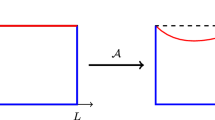Abstract
By employing a variational principle similar to Hamilton's principle, a finite element solution method for a fairly general class of inviscid, compressible fluid flows with flexible structural interfaces and/or free surfaces was developed in a previous paper. In this study, surface tension effects are added to the existing formulation by including the surface energy. We demonstrate the finite element implementation on test cases with analytical solutions: nonlinear static analyses involving a capillary tube and a droplet on a plane and linear frequency analyses of capillary/gravity waves, jet vibrations, and bubble oscillations. The method for incorporating surface tension is quite general and can be applied to nonlinear transient analyses as well.
Similar content being viewed by others
References
Bach, P.; Hassager, O. 1985: An algorithm for the use of the Lagrangian specification in Newtonian fluid mechanics and applications to free surface flow. J. Fluid Mech. 152: 173–190
Batchelor, G. K. 1967: An introduction to fluid dynamics. Cambridge: Cambridge University Press
Belvins, R. D. 1979: Formulas for natural frequency and mode shape. New York: Van Nostrand Reinhold Company
Curie, I. G. 1974: Fundamental mechanics of fluids. New York: McGraw-Hill
Georgiou, G. C.; Schultz, W. W.; Olson, L. G. 1990: Singular finite elements for the sudden-expansion and the die-swell problems. Int. J. Num. Methods Fluids 10: 357–372
Greenspan, H. P.; Benney, D. J. 1973: Calculus: An introducion to applied mathematics. New York: McGraw-Hill
Ho, L.-W.; Patera, A. T.: 1990: A Legendre spectral element method for simulation of unsteady incompressible viscous freesurface flows. Compt. Methods Appl. Mech. Eng. 80: 355–366
Ho, L.-W.; Patera, A. T. 1991: Variational formulation of three-dimensional viscous free-surface flows: natural imposition of surface tension boundary conditions. Int. J. Num. Methods Fluids 13: 691–698
Kistler, S. F.; Scriven, I. E. 1984: Coating flow theory by finite element and asymptotic analysis of the Navier-Stokes system. Int. J. Num. Methods Fluids 4: 207–229
Kock, E.; Olson, L. G. 1991: Fluid-structure interaction analysis by the finite element method—a variational approach. Int. J. Num. Meth. Engng. 31: 463–491
Lamb, H. 1945: Hydrodynamic. New York: Dover Publications
Rayleigh, J. W. S. 1945: The theory of sound. New York: Dover Publications
Ruschak, K. J. 1980: A method for incorporating free boundaries with surface tension in finite element fluid-flow simulators. Int. J. Num. Methd in Engng. 15: 639–648
Sackinger, P. A.; Brown, R. A. 1989: A finite element method for analysis of fluid flow, heat transfer and free interfaces in Czochralski crystal growth. Int. J. Num. Meth. Fluids 9: 453–492
Author information
Authors and Affiliations
Additional information
Communicated by S. N. Atluri, 18 October 1993
Rights and permissions
About this article
Cite this article
Olson, L., Kock, E. A variational approach for modelling surface tension effects in inviscid fluids. Computational Mechanics 14, 140–153 (1994). https://doi.org/10.1007/BF00350281
Issue Date:
DOI: https://doi.org/10.1007/BF00350281




